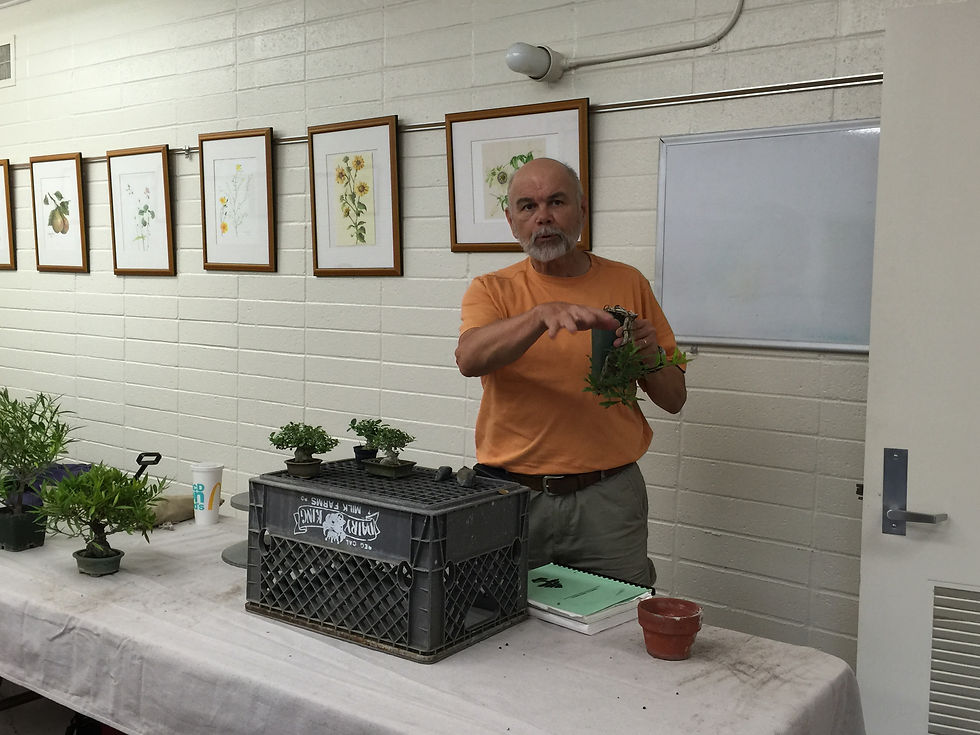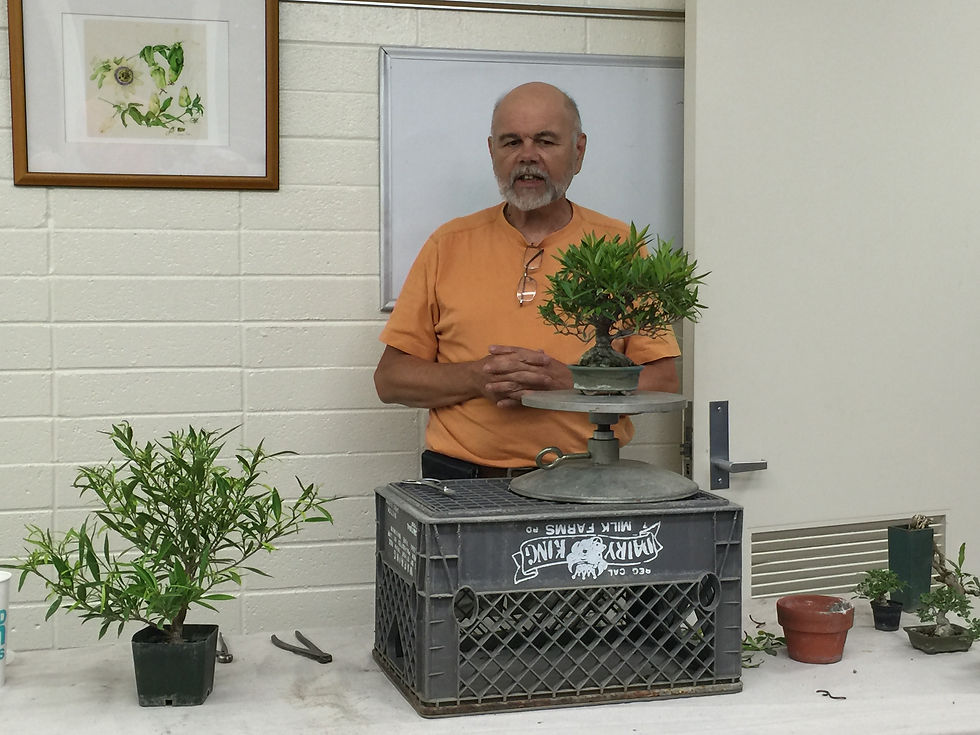Dr. Ted Matson back at it again!
- Tom Lau

- Aug 6, 2016
- 4 min read
It is great to have Ted back again at Baikoen Bonsai Club this past Thursday. Ted of course talked about the refinement process during this session. I really thought he explained and open the eyes of many people in the room no matter what skill level of bonsai they are at. Ted's refinement process focused around subtropical and tropical plants he brought from home.

Unlike some demonstrators Ted talks about several different species during a single session verse a single plant. For me, I'm a bit on the ADHD side, so it helps keeps the brain cells move during the entire 2 hours we had Ted.

The first subject up for discussion for the night was the little pomegranate he worked on the last time he visited us in 2015. The tree did grow some from its drastic root pruning and repotting. As Ted, told us he just let this little guy grow the entire year and this would be its 1st major cut back of the year.

Ted explains that with the wires removed and most of the branches and roots have set during this growing season we can start working on the overall appearance of the tree. While, we have some good growth all over the tree. We need to focus the tree's energy toward one of its apex and future pads.

Ted continues by saying we have one good apex and will use that as a starting point for the tree. He also states he is willing to save this branch because it will become a future upper pad for the tree and would like to see some more ramification. While, Ted explains all this he starts whack back the tree down to those two areas he mentioned he was going to save.

As a conclusion to this part. Ted said he will probably just let it sit on his bench and grow again until next year while he feeds it heavily for the next year.

Then Ted showed us one of his tropical reference books by Martha Goff called Tropical Green Sheets I and II. It is a reference book that was designed and developed by Martha because there was not a single handbook for tropical species in the bonsai world. After a quick glance, to me it is a reference book like John Naka's Technique I and II almost a must reference to have on hand if you like to develop tropical bonsai. You can purchase either book through Amazon: Tropical Green Sheets I and Tropical Green Sheets II by clicking the book you desire.

Ted switched gears again, and this time he was focusing on his mame Burt Davyi Nana Ficus. These ficus were cut grown and from a cutting given years ago. These are the smallest ficus I have seen with great ramification and movement. The only draw back with any ficus is that they are not cold hardy in our environment and do need special care during the Winter months.

Like all ficus, mid to late summer is the time to repot and trim them back into some form and shape. Ted gives all three Burt Davyi Ficus a haircut and calls it a night. These trees will respond by pushing new growth with smaller and smaller leaves. If you like to try your hand at growing one you probably need to contact a grower in Florida.

Ted again switches to Ficus Salicaria another type of ficus that makes great bonsai in a relative short time. He talks about how to make a great nebari with repotting into a nursery flat and letting grow for several seasons with heavy fertilization. He also said this ficus can take a beating and keep on ticking.

From the photo above you can see that he had no mercy for this ficus. He basically defoliation and whacked it back down to basic branches and from there he was selecting branches he wanted to keep. Finally, he had some wire and detailed wired two branches he wanted to lower in the overall composition.

Of course Ted brought another ficus salicaria for the club to raffle off. This was cut grown for several years and this would be its first major styling. Ted quickly discusses the good qualities of the tree and continues elaborate on the future of the tree.

After a quick chop with a concave cutter this was left. He explained earlier that you want to have some taper and movement in the trunk. If not you will not have an interesting piece to work on down the road. He said this would make a good mame or even shohin in a couple of years. The foundation was set and it was up to the new owner to grow its pads out and thicken its trunk.

Finally, Ted worked on this final specimen a dwarf mexican guava. Ted picked up several of these couple of years ago from a major grower in the San Fernando Valley region during the recession. As he said, "they were cheap and interesting so I took a chance."

What attracted Ted to these trees were its nebari. The roots were raised above the soil line and had what the japanese called Neagari or exposed root. It is not a common style of bonsai we see everyday, but it brings interest to the tree as Ted explains.

The major work of neagari style is to see which roots are alive and build from the nebari region up. The major feature as Ted explains is how the roots is lifted up and away from the soil line and how it grips the soil which makes it exciting to look at.

Ted does another drastic top chop and begins to repot. Again, we are here to develop the top and the neagari is the star of the show. But, with that in mind we will need to build the apex and main branches along the way. As a tropical plant we can expect this guava to throw a bunch of growth all over the major cut.

Here is a picture of the final product. Ted did talk about a ton of stuff at this meeting. I hope most of you that came took something home.

Big raffle winners of the night goes to Lindsay Shiba and Nick Hall! Congratulations gentlemen. I would love to see an update on both trees in about a year from now! Again, thank you Ted Matson for your informative demonstration of the night. I have yet again learned a ton from you!







Comments